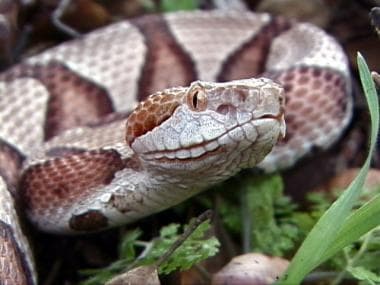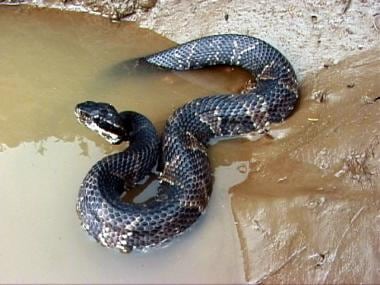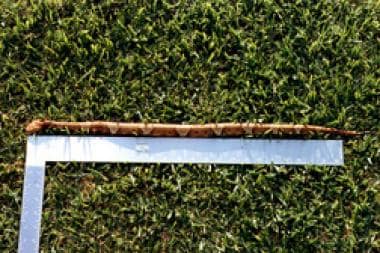Background
Moccasins are new world pit vipers (family Viperidae, subfamily Crotalinae), which may be identified by a heat-sensing pit anteroinferior to each eye, elliptical pupils, a triangular head, and undivided subcaudal scales. See the image below.
 Snake envenomations, moccasins. Copperhead (Agkistrodon contortrix). Photo courtesy of Sean Bush, MD.
Snake envenomations, moccasins. Copperhead (Agkistrodon contortrix). Photo courtesy of Sean Bush, MD.
Moccasins comprise the genus Agkistrodon, which includes the cottonmouth (Agkistrodon piscivorus) and copperhead (Agkistrodon contortrix) in the southeastern United States; the cantil (Agkistrodon bilineatus) in Mexico and Central America; the mamushi (Agkistrodon blomhoffii), Siberian pit viper (Agkistrodon halys), and Central Asian pit viper (Agkistrodon intermedius) in central and northeastern Asia; and the Malayan pit viper (Calloselasma rhodostoma) and hundred-pace snake (Deinagkistrodon acutus) in southeastern Asia. See the image below. This article specifically addresses the management of envenomation by the moccasin snakes found in the United States, A contortrix and A piscivorus.
 Snake envenomations, moccasins. Cottonmouth or water moccasin (Agkistrodon piscivorus). Photo courtesy of Sean Bush, MD.
Snake envenomations, moccasins. Cottonmouth or water moccasin (Agkistrodon piscivorus). Photo courtesy of Sean Bush, MD.
Pathophysiology
Envenomation occurs when the moccasin injects venom via hollow movable fangs located in the anterior mouth. The effects of moccasin envenomation are generally similar to rattlesnake envenomation. However, in most cases, moccasin envenomation is generally less serious than envenomation by rattlesnakes. For further discussion of more severe pit viper envenomation, see Rattlesnake Envenomation.
Moccasin venom is complex, with nearly 50 identified components. These can be broken down into the following four major categories [1] :
-
Proteolytic enzymes that directly destroy tissue, as happens in digestion of prey animals
-
Inflammatory mediators, including histaminelike and bradykininlike factors, that cause pain, erythema, swelling, and, occasionally, distributive shock
-
Fibrinolytic enzymes that cleave fibrin into ineffective D-dimers, resulting in coagulopathy
-
Antiplatelet factors that cause thrombocytopenia
Although neurotoxic factors can be detected in moccasin venom, clinically significant neurotoxicity does not occur with envenomation by copperheads or cottonmouths.
Etiology
A large percentage of bites are considered intentionally interactive—they occur when the snake is handled, kept as a pet, or abused. Many bites are associated with ethanol use.
Epidemiology
Frequency
United States
Approximately 9,000 patients are treated in US emergency departments (EDs) for snake envenomation each year. [2] Based on poison center data, moccasin snakes account for 56% of this total (50% copperheads and 6% water moccasins). [3] In portions of the southeastern United States, copperheads account for 85% of all reported snake envenomations. [4, 5] See the image below.
International
An estimated 1.8-2.7 million venomous snakebites occur each year worldwide. [6] The proportion of these caused by Agkistrodon species is not known.
Sex
Incidence of snakebite is higher in males than in females.
Age
Young adults are bitten most commonly. [7]
Prognosis
The American Association of Poison Control Centers (AAPCC) previously reported only two deaths from moccasin envenomation since its first annual report in 1983. In two retrospective studies of copperhead victims, patients missed a median of 2-6 weeks of work. Treatment with Crotalidae Polyvalent Immune Fab (ovine) was found to reduce limb disability measured by the Patient-Specific Functional Scale 14 days after copperhead envenomation. [8] Early administration of Fab antivenom resulted in faster limb recovery in copperhead snake envenomation. [9]
Nearly all patients fully recover after moccasin envenomation, although long-term disability has been reported. [10]
Some patients have long-term problems with limb pain and/or swelling, particularly after physical exertion. The proportion of patients who develop these sequelae and the relationship with initial clinical severity and treatment are not known.
Patient Education
Call professionals, such as animal control, to move snakes.
Never attempt to handle, possess, or kill venomous reptiles.
For patient education resources, see the patient education article Snakebite.
-
Snake envenomations, moccasins. Copperhead (Agkistrodon contortrix). Photo courtesy of Sean Bush, MD.
-
Snake envenomations, moccasins. Cottonmouth or water moccasin (Agkistrodon piscivorus). Photo courtesy of Sean Bush, MD.
-
Snake envenomations, moccasins. Copperhead (Agkistrodon contortrix). Photo courtesy of George Bush.
-
Wound measurement in snakebites. Courtesy of Carolinas Poison Center.
-
Crotaline treatment algorithm.










